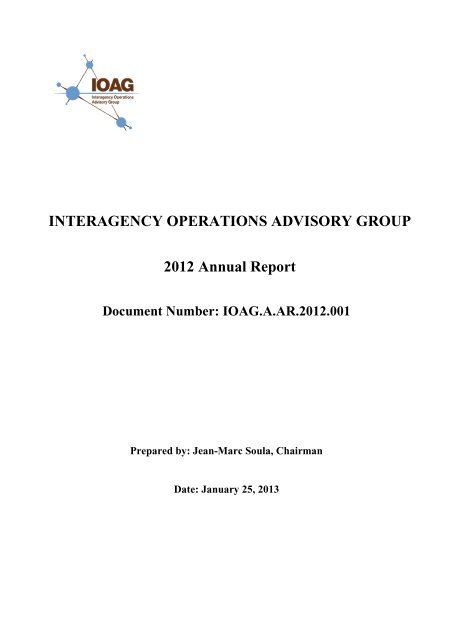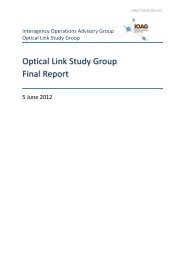IOAG 2012 Annual Report - Interagency Operations Advisory Group
IOAG 2012 Annual Report - Interagency Operations Advisory Group
IOAG 2012 Annual Report - Interagency Operations Advisory Group
Create successful ePaper yourself
Turn your PDF publications into a flip-book with our unique Google optimized e-Paper software.
INTERAGENCY OPERATIONS ADVISORY GROUP<br />
<strong>2012</strong> <strong>Annual</strong> <strong>Report</strong><br />
Document Number: <strong>IOAG</strong>.A.AR.<strong>2012</strong>.001<br />
Prepared by: Jean-Marc Soula, Chairman<br />
Date: January 25, 2013
<strong>IOAG</strong> <strong>2012</strong> <strong>Annual</strong> <strong>Report</strong><br />
This <strong>2012</strong> <strong>Annual</strong> <strong>Report</strong> of the <strong>Interagency</strong> <strong>Operations</strong> <strong>Advisory</strong> <strong>Group</strong> (<strong>IOAG</strong>) provides an<br />
overview of the activities conducted over the past year, with reference to the objectives<br />
defined in the <strong>IOAG</strong> <strong>2012</strong> Work Plan. It is intended to keep all stakeholders and partners<br />
informed of the <strong>IOAG</strong>'s work and achievements in the domain of space communications, in<br />
line with the mandate given by the second Interoperability Plenary (IOP-2) held in Geneva at<br />
the end of 2008.<br />
At the <strong>IOAG</strong>-16 meeting in December <strong>2012</strong>, the <strong>IOAG</strong> has elected a new Chairman, Mr<br />
Michael Schmidt (ESA), who will take over from Mr Jean-Marc Soula (CNES) right after the<br />
IOP-3 meeting, planned on June 25-26, 2013. It was agreed that a transition will be organized<br />
in the period preceding the IOP meeting.<br />
Year <strong>2012</strong> was not simply a year of transition and preparation on the way to the IOP-3<br />
meeting; it was also a year of significant achievements as identified below.<br />
In the close relationship with the Consultative Committee for Space Data Systems [CCSDS],<br />
several significant contributions were made from both sides:<br />
- Monitoring of the progress made by the CCSDS in the development of a Solar System<br />
Internetworking (SSI) candidate architecture and its suite of supporting standards<br />
(e.g.: DTN). In the first half of 2013, the <strong>IOAG</strong>’s Space Internetworking Strategy<br />
<strong>Group</strong> (SISG) will be revived to verify that the CCSDS proposals meet the <strong>IOAG</strong><br />
expectations and may be endorsed by the member agencies for future<br />
implementations. The acknowledgement of the SSI definition will be one of the main<br />
topics on the agenda of the IOP-3;<br />
- Establishment of the web based “<strong>IOAG</strong>-CCSDS Product Agreement” by which <strong>IOAG</strong><br />
will establish priorities and target dates in the production of cross support standards<br />
and by which CCSDS will report on the progress made and, eventually, on difficulties<br />
to meet the <strong>IOAG</strong> objectives;<br />
- Contribution from <strong>IOAG</strong> to the identification of optimized requirements for the<br />
Service Management of the Cross Support services in the frame of the ground-based<br />
Cross Support Service Catalogue, called “<strong>IOAG</strong> Service Catalogue #1.”<br />
The above activities have been reviewed on the occasion of the <strong>IOAG</strong>-16 held in the<br />
Kennedy Space Center in December <strong>2012</strong>, part of this meeting being a joint session<br />
with the CCSDS Management Council. This meeting was also the occasion to<br />
exchange views on other subjects currently at work on the <strong>IOAG</strong> side and that may<br />
have implications on CCSDS plan of work in the future, depending the decisions of<br />
the IOP-3, in particular on Mission <strong>Operations</strong> Services and on Optical<br />
Communications (see below).
Several <strong>IOAG</strong> initiatives came to a conclusion in Year <strong>2012</strong>; those include:<br />
- The “Optical Links Study <strong>Group</strong>” (OLSG) was formed in late 2010, with the objective<br />
to assess the need and the conditions for cross support in various mission scenarios.<br />
The study was concluded in <strong>2012</strong> with a final report submitted at the <strong>IOAG</strong>-15b<br />
meeting and an addendum, on the technical aspects to be standardized, at the <strong>IOAG</strong>-16<br />
meeting. The report will be the basis of a presentation to the IOP-3 aiming at pointing<br />
out the interest of optical communications, the insertion opportunities and the need to<br />
establish the supporting standards according to an agreed roadmap.<br />
- The establishment of the collective <strong>IOAG</strong> top priorities on activities to be developed<br />
in the upcoming decade was finalized and reports were produced, on the priority<br />
standards and technologies that will lead to significant benefits (operational and/or<br />
financial) and standards for capabilities or services that will be committed to flight<br />
operations or tracking networks in the short term. These reports were sent first to the<br />
CCSDS and, more recently, to the Agencies Management, to stress the need for<br />
consistent support to the related studies and standards developments. Addressed are<br />
the domains of the coordination on space debris, the anticipated need for higher data<br />
rates, the space link security, the technologies for the exploration of the solar system<br />
and the management of cross support configurations.<br />
The effort to strengthen the relationship with other international communities was pursued so<br />
as to establish the central role of the <strong>IOAG</strong> in the domain of Space Communications, in<br />
coordination with, on the one hand the projects and the international user communities and,<br />
on the other hand, the standardization organizations. Positive indications of this consolidation<br />
are:<br />
- The coordination made with the International Space Exploration Strategy <strong>Group</strong><br />
[ISECG] so that clear statement is made, in the next version of their roadmap, that the<br />
ISECG will rely on the recommendations of <strong>IOAG</strong>, jointly with the CCSDS and the<br />
SFCG, on communication architectures, standards and concepts to support their<br />
mission scenarios.<br />
- The liaison with the Space Frequency Coordination <strong>Group</strong> [SFCG] concentrated this<br />
year on the consistency of the SFCG and <strong>IOAG</strong> mission models and on the<br />
preparation of the ITU WRC-15 on subjects of common interest, including frequency<br />
and spectrum utilization.<br />
- The liaison with the International Coordination on GNSS [ICG], agreed in 2011,<br />
developed with the attendance of <strong>IOAG</strong> to the ICG-7 meeting in November <strong>2012</strong> that<br />
was an occasion for presentations and discussions on the user requirements and<br />
mission models in the domain of Positioning, Navigation and Timing (PNT), in<br />
particular for the GNSS Space Service volume.<br />
In <strong>2012</strong>, the <strong>IOAG</strong> also initiated new activities or resumed former ones that will develop in<br />
2013, at least up to the IOP-3. This includes:<br />
- The LEO 26 GHz Study <strong>Group</strong> [LEO26SG] was formed in the third quarter of <strong>2012</strong>,<br />
with the objectives to:
o Facilitate the utilization of 26 GHz K-Band (i.e. (25.5-27.0 GHz) direct space<br />
to Earth data downlink for future LEO missions, in the context of crosssupports.<br />
o Develop high level Concepts of <strong>Operations</strong> and preliminary Architecture<br />
inputs for a 26 GHz K-Band ground system for low Earth orbit.<br />
o Determine the business case for cross support at 26 GHz for low Earth orbit<br />
applications.<br />
A progress report is to be presented at the IOP-3, including High-Level Concepts of<br />
<strong>Operations</strong> and Business Case Analysis, Summary of preliminary Architecture,<br />
Definition of Standards, Models and Technologies Requiring Development.<br />
- The “Mission <strong>Operations</strong> Services Coordination <strong>Group</strong>” [MOSCG] which had been<br />
suspended in mid-2011 was revived at the <strong>IOAG</strong>-16 meeting, in order to prepare for a<br />
presentation to the IOP-3 and decisions on the interest of the subject, the challenges<br />
and the implications of <strong>IOAG</strong> to elaborate a strategy and plans for interoperability in<br />
this domain. Considering the required expansion of the scope of <strong>IOAG</strong> to cover the<br />
Mission <strong>Operations</strong> domain, but also the significant efforts to be made in developing a<br />
third <strong>IOAG</strong> service catalog and its related standards, the <strong>IOAG</strong> will seek guidance<br />
from the IOP-3 on the way forward.<br />
In <strong>2012</strong>, the <strong>IOAG</strong> held four teleconferences, one intermediate meeting in Stockholm (June<br />
<strong>2012</strong>) and one plenary session, <strong>IOAG</strong>-16, in Florida (December <strong>2012</strong>). These meetings gave<br />
the <strong>IOAG</strong> the opportunity to address all of the above subjects but also to continue the<br />
exchanges between the members and to update the <strong>IOAG</strong> reference tables that are displayed<br />
on the web site: Communication Assets, Mission Model, Cross Support Mission Model and<br />
Standard Infusion Plans (in preparation). The <strong>IOAG</strong> continued to improve its processes so as<br />
to provide a forum for space agencies to share their cross support experiences and plans with<br />
the view to working collectively towards the further development and implementation of<br />
standardized interfaces.<br />
In addition to the follow-up of the already engaged activities, on the agenda of the <strong>IOAG</strong><br />
meetings for 2013 are the preparation of the IOP-3 and the continuous promotion of the<br />
services and their supporting standards as elected by the <strong>IOAG</strong>.<br />
Tentatively, five meetings are scheduled in 2013 to iterate on these subjects:<br />
- <strong>IOAG</strong>-16a: tele-videoconference on 5 March<br />
- <strong>IOAG</strong>-17: plenary meeting hosted by the UK-Space Agency at the RAL, on the week<br />
of 13~17 May<br />
- <strong>IOAG</strong>-17a: tele-videoconference on 4 or 11 June (TBC)<br />
- IOP-3: meeting hosted by CNES in Toulouse, on June 25~26<br />
- <strong>IOAG</strong>-17b: tele-videoconference, within one or two months after the IOP<br />
- <strong>IOAG</strong>-18: plenary meeting hosted in the November - December timeframe<br />
Involvement of all members and contributions to the actions in progress are the condition for<br />
a successful preparation of the IOP-3. This is being reminded to some members who were<br />
deficient in the last years.<br />
For any further information please consult the <strong>IOAG</strong> web site (www.<strong>IOAG</strong>.org) or contact the<br />
<strong>IOAG</strong> Secretariat (Barbara.Adde@nasa.gov).



